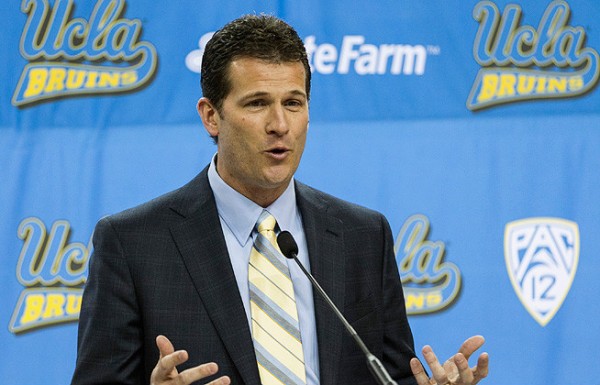Three Questions Previewing Duke and UCLA Tonight
Posted by Brian Otskey on December 19th, 2013When Duke and UCLA lock horns for the first time in 11 years tonight at Madison Square Garden in New York City (7:30 PM EST, ESPN), plenty of offensive fireworks figure to be on display. These teams are elite offensively with UCLA ranking third nationally in points per game at 89.1 and Duke not too far behind at 86.0. For as potent as these teams are offensively, their defenses leave a lot to be desired. What we have is a recipe for an up-tempo game, lots of points, and a fun viewing experience. There are also plenty of intriguing match-ups in this game when you look at each squad’s style of play. While their statistics are similar, the teams are constructed very differently. Let’s take a look at three key questions that will decide the result of this contest.
1. Can UCLA guard the three-point line?
Much has been made of Duke’s defensive issues but defense has also been a problem for Steve Alford’s Bruins, especially when it comes to guarding the all-important three-point line. The Bruins’ 2-3 zone was torched by Missouri in their only loss of the season back on December 7. Missouri made 10 threes which proved to be the primary difference in the game. As a whole, Duke shoots 42 percent from beyond the arc and 45 percent of all Blue Devils’ field goal attempts are triples. Mike Krzyzewski’s team features four lethal perimeter threats and that may be too much for the Bruins to handle. While UCLA’s zone may help contain Duke’s versatile forwards from cutting to the basket, it opens the door for a Blue Devil three-point bombardment. Alford may be forced to extend the zone but his team’s performance will come down to the effort of guards like Norman Powell and a pair of freshmen (Zach LaVine and Bryce Alford) getting out to cover Duke’s shooters.
2. Will Duke be able to prevent UCLA from getting into the paint?
For as much as UCLA struggles guarding the three-point arc, you can say the same for Duke when it comes to defending the paint. Coach K has rarely had an elite rim protector like Jim Calhoun had in his time at Connecticut or John Calipari has had at Kentucky in recent years, but he has never had a team like this one either, which starts three 6’8” forwards (Jabari Parker, Rodney Hood and Josh Hairston) and lacks any semblance of a back-line defender. Consequently, Duke ranks No. 249 in defensive block percentage (7.5%) according to Ken Pomeroy’s statistics and No. 250 in two-point field goal percentage allowed (51.8%). This plays right into UCLA’s strengths, a team that shoots 59.3 percent inside the arc, third best in the country. Kyle Anderson’s ability to distribute and get into the paint opens up a lot of offensive options for the Bruins. If UCLA decides to go big with David and Travis Wear and Tony Parker, Duke will have multiple match-up problems on the defensive end of the floor. Even if Alford decides not to involve his big men a bit more into UCLA’s guard-oriented offense, just their presence alone on the court will create even more defensive match-up problems for the Blue Devils, which could allow UCLA’s guards to have an easier time getting into the lane.
3. Who does Coach K assign to Kyle Anderson?
UCLA’s Kyle Anderson is at or near the top of the list of the most difficult players in America to match up with. After playing forward for Ben Howland last season, Alford has allowed the 6’9” sophomore to move back to his natural point guard position, and the results have been stellar. Anderson is averaging 13.8 PPG, 8.7 RPG and 6.7 APG through UCLA’s first 10 games and his field goal shooting has increased by nearly nine percent over last year. The decision on who guards Anderson can have wide-ranging ramifications for Duke. Quinn Cook may start on him because his quickness can be an asset against the man nicknamed “Slo-Mo” for a reason. Tyler Thornton, arguably Duke’s best defender, is also another viable option. However, Anderson’s height can be a major issue for the Blue Devil guards despite his lack of exceptional foot speed. If that proves to be the case, Krzyzewski may be forced to put one of his forwards on Anderson, which could result in major defensive issues for Duke at other positions, a risk Coach K may not want to take. Duke will probably go with Cook or Thornton for the majority of the game but may experiment at times with different defenders (maybe Hood or Parker?). Anderson’s play will be key to the outcome of this game and Duke will be hoping that quickness trumps length and versatility in this particular game.
On an otherwise slow Thursday night in college basketball, this is a must-see game. It is almost guaranteed to be aesthetically pleasing and should be close throughout. Plus, who doesn’t love a blueblood match-up between two of college basketball’s most storied programs?












































